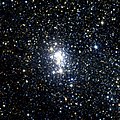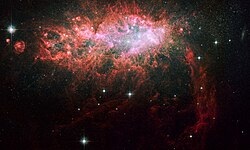Super star cluster
Super star clusters are huge star clusters of very young large stars. They are thought to be precursors of globular clusters.[1] Their short-lived huge blue stars emit lots of UV radiation which ionises the surrounding gas. Examples are Westerlund 1 and 2 in the Milky Way, and R136 in the Larger Magellanic Cloud. Nearby galaxy NGC 1569 has two SSCs.
Super Star Cluster Media
R136 is an example of a super star cluster
New observations with ESO’s Very Large Telescope show the star cluster RCW 38 in all its glory. This image was taken during testing of the HAWK-I camera with the GRAAL adaptive optics system. It shows the cluster and its surrounding clouds of brightly glowing gas in exquisite detail, with dark tendrils of dust threading through the bright core of this young gathering of stars.
References
- ↑ Gallagher & Grebel (2002). "Extragalactic star clusters: speculations on the future". Extragalactic Star Clusters, IAU Symposium. 207: 207. arXiv:astro-ph/0109052. Bibcode:2002IAUS..207..745G.






